|
Dutch
Barn Preservation Society
Dedicated
to the Study and Preservation
of New World Dutch Barns
NEWSLETTER
SPRING 2000, Vol. 13, Issue 1, Part Two
DUTCH BARN
OBSERVATIONS
By Harold Zoch
Here in the Schoharie Valley we have been viewing and documenting
barns. Many of the observations and documentation were extremely
important since these are all that remains of the barns. I estimate
that 30 to 40 percent of our barns are gone. From the original
Palatine settlement of Hartmans Dorf six of seven barns that were
there are gone.
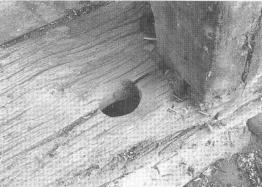 Observations
have shown the evolution of the barns from original settlement
to present day. In addition we have seen associated artifacts and
structural features which may be unique to Schoharie Valley. We
hope that via this article we will get response showing like artifacts
in other areas and perhaps some idea of their use. As an example
I have not found a Dutch Barn with doors on both gabled ends in
this area. Observations
have shown the evolution of the barns from original settlement
to present day. In addition we have seen associated artifacts and
structural features which may be unique to Schoharie Valley. We
hope that via this article we will get response showing like artifacts
in other areas and perhaps some idea of their use. As an example
I have not found a Dutch Barn with doors on both gabled ends in
this area.
A typical unmodified Dutch Barn in this area would be a four bay
approximately 40 feet square. The granary would be located in the
back right bay. It appears the first modification is to add another
bay on the back end. Back here refers to the end opposite the gabled
door end. The next modification appears to add a side door on the
right side to the original back bay. This was the back bay prior
to the addition of the fifth bay. Within this sequence perhaps
the addition of a second door, for drive through, to the opposite
side, follows or perhaps is concurrent with this last modification.
Modification for side doors are easily spotted as modifications
to existing structures. Later in time it appears side doors are
no longer modifications but part of the original structure. The
greatest modification in the Schoharie Valley to Dutch Barns is
the addition of another barn perpendicular to the original barn
forming a "T" on the back end. All of this type appear
to be modifications and not original configurations.
As a side note here I have found one German or English Barn,
I do not know the  difference,
with 1790 nails in the original siding, making them contemporary
with Dutch Barns here. difference,
with 1790 nails in the original siding, making them contemporary
with Dutch Barns here.
Artifacts and Structural Features Described here are two separate
observations. The first is a pole approximately 15 feet long that
has a crochet hook shape on one end. The hook is on the larger
diameter end. These have been seen in three barns all within 5
miles of each other. The hook end does not show signs of ware.
One barn contained two another barn, now gone, had one and our
barn at the Old Stone Fort has one. Photos here show configuration.
The second is a structural feature that has been observed on
three Dutch Barns. The three were within a dozen miles of each
other, two adjacent to each other. One is gone.
The second feature is associated with the gabled end large door
frame. Within the large door frame holes are observed in the sill
and the end anchor beam. These holes are about 3 inches in diameter.
The holes are located about 3 inches inboard of the door post in
the sill and overhead end anchor beam. I have
found only one remaining in a sill but have no doubt others were
present. Sill replacement or repair probably accounts for the loss
of others. The remaining one is very important because it shows
a circular wear pattern associated with the hole- see photo.
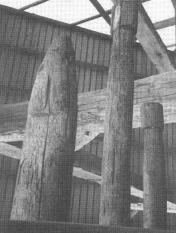 While
documenting barns I always look for the worn tenon in the center
of the anchor beam. In the gabled end door opening. Most of the
companion holes are usually missing again probably due to sill
ware or repair. These holes described here show no ware, except
for door support poles. The only wear found was associated with
the one remaining one in the sill. While
documenting barns I always look for the worn tenon in the center
of the anchor beam. In the gabled end door opening. Most of the
companion holes are usually missing again probably due to sill
ware or repair. These holes described here show no ware, except
for door support poles. The only wear found was associated with
the one remaining one in the sill.
From the beginning, based
on their location, the thought of affiliation with the door arose.
If two saplings, like the door center support pole, were placed
in these holes perhaps a door could be fastened to these saplings
or polls. Perhaps the circular wear pattern in the photo supports
this idea. The door in this configuration could be opened inward
or outward.
The purpose of any documentation
is to record and provide for discussion. Has anyone else observed
similar artifacts or structural features?
CAPACITY OF THE BARN
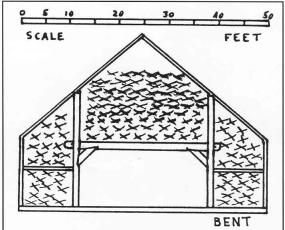
By R. J. Andersen
When the colonial farmer graduated from the barrack storage
structure to the 5 bay American-Dutch Barn he increased his storage
capacity more than 10 fold. The barrack capacity was said to be
10 tons. (Shirley Dunn, DBPS News Letter, fall 1989, page 4.) Using
the drawing below,the barns capacity can be calculated starting
with its total volume:
Length x Width x Average Ht. = Volume
50 x 50 x 26 = 65,000 Cu. Ft.
We must deduct the threshing floor which is not usually used for
storage, 50 x 28 x 12 = 16,800 Cu. Ft. Total 65,000 Threshing FIr.
(-) 16,800
Storage 48,200 Cu. Ft.
There must be allowance for framework and head space, so that
the maximum, actual storage space is more like 75%.
75% x 48,200 = 36,150 Cu. Ft. Wheat
It would be simple to calculate how much straw (400 Cu. Ft. per
ton) or how much grain (1.24 Cu. Ft. per Bu.) could be contained
in the 36,150 Cu. Ft., however the sheaves of wheat contain a mixture
of both. Therefore a problem arises as to the compromise between
the two. Old wheat (1680) had long straw and short yield. New wheat
(1990) has short heavy straw and long yield. The modern day wheat
is bred to resist lodging. Present day yields are easy to come
by, but assumptions must be made in the case of old wheat. When
the author weighed a few stalks of wheat (1998) he found that straw
and grain were of equal weight. This was verified in an interview
with the Hillman brothers, of Selkirk, NY, the last wheat growers
in Albany county, I was told-that their yields were 60 Bu. of grain
per acre and 100 bales of straw, at 36 lbs. each. This amounts
to 3600 lbs. of grain and 3600 lbs. of straw. We are going to assume
that old wheat had the same grain to stalk relationship, 50/50.
Wheat in the barn consists of bundles of straw with grain attached.
Using common tables, weights are as follows:
Straw at 400 Cu. Ft. per ton (2000 lbs.)
Grain at 60 Lbs. per Bushel (1.24 Cu.Ft.)
Thus
One Cu. Ft. of straw weighs 5 Lbs. One Cu. Ft. of grain weighs
48 Lbs. And
10 lbs. of straw occupies 2.0 Cu. Ft. 10 lbs. of grain occupies
.21 Cu. Ft.
20 lbs. of crop occupies 2.21 Cu. Ft.
And
9 lbs. of crop occupies 1 Cu. Ft.
Thus--
The net crop space of 36,150 Cu. Ft. enabled the farmer
to store 325/350 lbs., one half of which is grain, or 162,675 lbs.
This is 2711 Bu. of grain, at 60 lbs. per bu.
At an average yield of 10 Bu. per acre, it would require 271
acres of wheat to fill the barn.
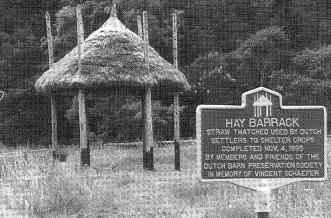
Wemp Barn with Barrack, Feura Bush, NY
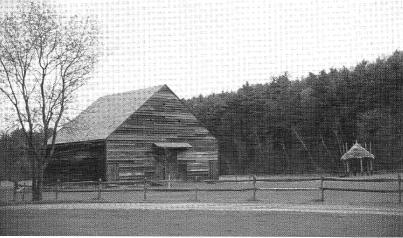
|